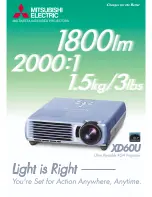
appropriate security settings for the wireless LAN device.
Some wireless LAN devices may not be set for security immediately after purchase. To decrease the possibility
of occurrence of security problems, be sure to make all security related settings according to the operation
instructions supplied with each wireless LAN device before using a wireless LAN device.
Depending on the specifications of the wireless LAN, a malicious third party may be able to break security settings
by special means.
Panasonic asks customers to thoroughly understand the risk of using this product without making security
settings, and recommends that the customers make security settings at their own discretion and responsibility.
Notes regarding the wireless LAN
Wireless connection function of the projector uses radio waves in the 2.4 GHz band.
A radio station license is not required, but be sure to read and fully understand the following items before use.
The wireless module (Model No.: AJ-WM50) of optional accessories must be installed when you want to use the
wireless LAN function of the projector.
r
Do not use near other wireless equipment.
The following equipment may use radio waves in the same band as the projector.
When the projector is used near these devices, radio wave interference may make communication impossible, or
the communication speed may become slower.
f
Microwave ovens, etc.
f
Industrial, chemical and medical equipment, etc.
f
In-plant radio stations for identifying moving objects such as those used in factory manufacturing lines, etc.
f
Designated low-power radio stations
r
Do not use cell phone, television, or radio as much as possible close to the projector.
Cell phone, television, or radio is using radio wave with different bandwidth from the projector, so there is no effect
on the wireless LAN communication or the send/receive on these devices. However, noise may occur in the audio
or video due to the radio wave from the projector.
r
Wireless communication radio waves cannot penetrate steel reinforcements, metal,
concrete, etc.
Communication is possible through walls and floors made from materials such as wood and glass (except glass
containing wire mesh), but not through walls and floors made from steel reinforcements, metal, concrete, etc.
r
Avoid using the projector in locations prone to static electricity.
If the projector is used in a location prone to static electricity, the wireless LAN or wired LAN connection may be
lost.
If the static electricity or noise make it impossible to establish a connection with the LAN, disconnect the power
plug from the outlet after turning off the projector power, eliminate the source of static electricity or noise, then turn
on the projector.
DIGITAL LINK
(Not available for PT-VMZ51S and PT-VMZ41)
“DIGITAL LINK” is a technology that uses a twisted-pair-cable to transmit video, audio, Ethernet, and serial control
signals. It is developed based on the communication standard of HDBaseT
TM
established by HDBaseT Alliance
and added with other features of Panasonic.
This projector supports the optional Panasonic DIGITAL LINK output compatible device (Model No.: ET-YFB100G,
ET-YFB200G) and peripheral devices by other manufacturers (twisted-pair-cable transmitters such as the “XTP
transmitter” of Extron Electronics) that use the same HDBaseT
TM
standard. For the devices of other manufacturers
that the operation has been verified with this projector, visit the Panasonic website (https://panasonic.net/cns/
projector/). Note that the verification for devices of other manufacturers has been made for the items set by
Panasonic Corporation, and not all the operations have been verified. For operation or performance problems
caused by the devices of other manufacturers, contact the respective manufacturers.
Application software supported by the projector
The projector supports following application software. For details or downloading each application software, visit
the Panasonic website (https://panasonic.net/cns/projector/).
ENGLISH
-
19
Chapter 1 Preparation - Precautions for use
















































